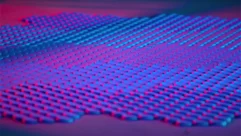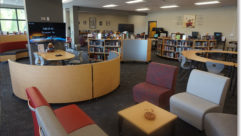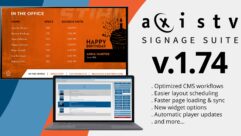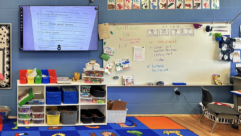 On this edition of the SVC Podcast, Contributing Editor Bennett Liles talks with Adam Yates of the Nisewonger Audio Visual Center in Lawrenceville, Georgia about their installation of an all new Visix digital signage and AV collaboration system for the Hall County School District. Adam details the Visix AxisTV digital signage software and he discusses the installation of LG displays, their connection to video and power and the user training Nisewonger AV provided.
On this edition of the SVC Podcast, Contributing Editor Bennett Liles talks with Adam Yates of the Nisewonger Audio Visual Center in Lawrenceville, Georgia about their installation of an all new Visix digital signage and AV collaboration system for the Hall County School District. Adam details the Visix AxisTV digital signage software and he discusses the installation of LG displays, their connection to video and power and the user training Nisewonger AV provided.
FOR MORE: GO TO PART 1
Links:
- Nisewonger Audio Visual Center
- Visix AxisTV Digital Signage Software
- Crimson AV T63A Universal Tilting Wall Mount
In North Georgia, the Hall County School District is huge and the schools were all using different digital signage systems. They needed a unified system that all the schools could use and the long-time experts at Nisewonger Audio Visual Center in Lawrenceville brought in the solution with Visix. Nisewonger’s Adam Yates has the whole story right now on the SVC Podcast.
Adam, it is indeed a treat to have you with us on the SVC Podcast from Nisewonger Audio Visual Center in Lawrenceville, Georgia. Right up the road from me. We’re going to be talking about a huge digital signage and collaboration project for the Hall County school system but first tell us about Nisewonger AV. You’ve been around for a good while so how did it all get started?
Sure, sure. Well thanks, Bennett, for having me. So Nisewonger AV, we are a family owned and operated company. So my wife’s grandfather, Jim Nisewonger, started the company back in 1968, so last year we were able to celebrate our 50th anniversary. So 50 years in business as a small business in the educational AV space is pretty awesome so we’re very blessed. I would say we’re kind of second/third generation right now. Jim’s son Randy is our President and CEO and my wife, Ashley, and I kind of help run the business. She’s more on the operations side and I’m more focused on the sales and business development side. So we really started out, honestly, as a company, as humble beginnings. Started in the basement of their home and [Laughs] now we’ve advanced. We’ve got an office here in Lawrenceville, we’ve got 10 employees and really the basis of our company is based around service. We say – kind of our tagline is “Advancing technology with old-fashioned personal service.” And so we’ve kind of built on specifically three things, being innovation, design and integrity. So it really makes up who we are as a company. [Timestamp: 2:04]
1968! Your outfit has been around long enough to have seen a lot of AV technology come and go.
We sure have. I’ve got an old catalog here that we pulled out of storage about a year ago and it’s – I think it’s from about 1978 – and we’ve got reel-to-reel projectors and the old, old equipment that they used to use in schools. So that was kind of a museum of technology that we were able to flip through and say this was our company circa 1978, so to speak. [Timestamp: 2:33]
And it looks like you focus primarily on education.
We do, yeah. So we have maintained that and we’ve stayed rather small. We’re just here in the state of Georgia, and really our main focus is that K-12 education market. So that market has been very good for us, been very good to us, and really comprises probably 85-90 percent of our business. And so it’s a very interesting market and the technology is changing very rapidly, even in the K-12 market which is surprising to some people. [Timestamp: 3:05]
You’ve had a big one here with the Hall County School System. Now Hall County is right in your neighborhood, all that land that surrounds beautiful Lake Lanier. They’ve got something like 20 elementary schools, 7 middle schools, 7 high schools. That’s a lot of ground to cover to get them outfitted with a unified digital signage system.
That’s right. Yeah, that’s right. So Hall County Schools has about 37 schools with roughly 27,000 to 28,000 students. So it’s a growing district; especially on the south end it’s really starting to expand. We’re seeing a lot of growth on that end of the county. And when they came to us the focus was on visual signage. We do a lot of work for them, from AV and media center café spaces. We do furniture design layouts for them, kind of renovating these spaces and focusing in on how we can integrate the furniture with the technology together. And when they came to us for digital signage we went directly to Visix as this enterprise-level solution. They came to us and they really wanted a digital messaging interface that acted really as a central messaging platform for the district and for the schools and so Visix was just a natural fit for that particular application. [Timestamp: 4:22]
And Visix is in your neighborhood, too. I think they’re headquartered in Norcross.
They are. That’s right.
So that’s only about 15 miles away.
That’s correct. That’s really come in handy because we’ve been able to invite people from Visix directly to Hall County to kind of talk through things and we’ve been able to meet together and discuss as the projects have come along now. We have over 300 players now throughout the district, so we have pretty much every school now has the digital signage platform in their school and they’re running it on a day-to-day basis. And it’s becoming I wouldn’t say fully mission-critical at this point, but people have come to really rely on this method of communication. [Timestamp: 5:05]
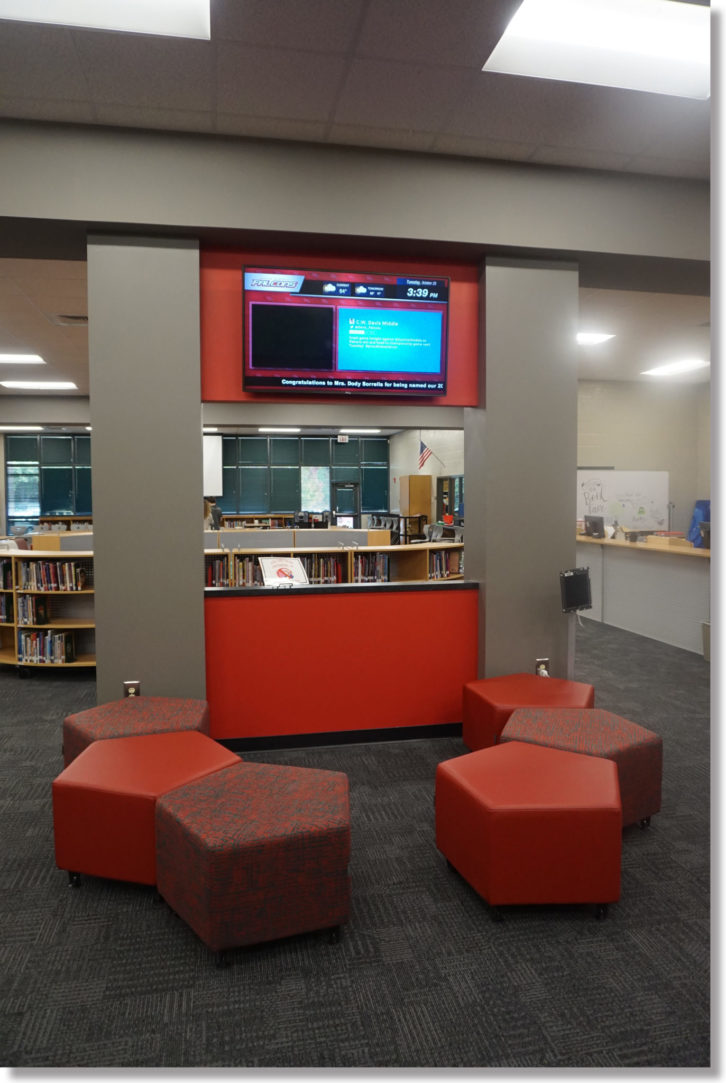
Tell me a little about how the Visix AxisTV System works. They were using various other kinds of systems and all the schools weren’t on the same page with it.
Yeah. So they had a previous system. They had a couple of different versions of it. It really wasn’t focused on digital signage. So we kind of looked at different solutions and one of the reasons we focused in on Visix was because that’s what they do. They’re fully enterprised in on digital signage and they’re completely focused in on that. And Hall County was using some IPTV-type solutions; a conglomeration of a couple of different solutions, not really set on one specific. So when we decided to go this direction they were ecstatic to get something in place that could be controlled at the district level but then pushed down to each individual school. And I hope I get the opportunity to discuss that with other districts how they’ve done it because they’ve really done it in a unique way. It’s given the school some autonomy within the entire framework of the digital signage platform. So what we did, what Visix did and us together is we created some templates for the schools. So the schools have some standardized templates that they can use, but within that they’ve got some custom content and they have some customized background and layouts so each individual school has some uniqueness about it where they’ve got their logo, their colors, their kind of style sheet within it. However, if you go from school to school to school you see some continuity there. If you look up at their screens in the front office you know from school to school that’s the same platform, so there’s a lot of continuity there. However, there’s some unique styles within each school so they can kind of maintain their uniqueness within the district. [Timestamp: 6:51]
And for security and so forth they’ve got different user authorizations set up on that.
That’s right. So they use Active Directory for their user information and then what they can do is, which they absolutely love, is they can give certain faculty, certain staff members, different user access to the Visix digital signage platform software. So say so-and-so in the front office, maybe he or she just needs to be able to send a message out; maybe a simple message or something like that. So the other more complex capabilities may be taken away from that user because that’s all they need to do. Or say the media specialist, for instance, that’s kind of our point of contact within the school district. For the individual school they’re somewhat in charge of the Visix system, I guess. And so they may have additional user access to be able to do that. And then the great thing about this enterprise-level system is the district, they can push down content at the district level to the schools and also give the schools some independent access to that content and communication to be able to communicate their individual message to their students, faculty, parents and so on. [Timestamp: 8:02]
And of course they all know each other in the different schools and so if anybody hits a snag all they have to do is talk to somebody in their school or one of the other ones and they don’t have to come back to your people for every little detail.
Yeah, that’s right. That’s right.
Now, there was some hardware installation involved in this I think. You had some displays to install. You already had network, power and cabling in place so that sure would have sped up things.
Yeah.
I think I saw that you used LG displays in there.
We did. We’ve been very loyal to the LG brand. It’s been an incredible brand for us. They were one of the first display companies to really come out with what I would consider kind of an entry-level commercial display. So it’s a great display. It’s built for commercial use. It’s built for this environment that we’re working in – the school environment – but it’s at a price point that the schools can afford. So again, it’s not a consumer-grade TV that we can take off the shelf for a very low price, however it comes with a two-year commercial warranty that’s made to stay on 16-24 hours out of the day and so therefore that becomes very important in the school environment because these are running constantly; at least 12 hours a day if not more. They may even stay on overnight or over the weekend. So it’s important that we put in a display that’s going to last the test of time for that type of environment. [Timestamp: 9:25]
And this goes way beyond just being a notification system. They can put up student artwork, they can do all sorts of things with this now and other schools have taken notice.
That’s right. And so they’re kind of this flagship system that’s really taken digital signage to the next level. I can’t say enough about Hall County and what they’re doing because they’re taking it not only as a communication tool for the district – to the schools, to the parents and the individual schools – but yes, they can actually display student work, events coming up. They have do, you know, if they’ve got a parent meeting they can disseminate a lot of information at the push of a button with this system and that’s really the beauty and the power of it. Because as we know, these days everyone’s got a device in their hand. I mean, we’re consistently looking at our phones or tablets or computers. We’re looking all around for that information and it has to be disseminated in a proper way. And digital signage just makes sense in that school environment. [Timestamp: 10:19]

And when you put in the displays your people had already installed most of the display connection wall plates at an earlier stage of this.
Yes. So what we did was we had the network data guys come in and pull the data to that particular location. So those locations were tagged as spots for digital signage within the schools and then power and data was pulled to those spots. So when we came in we would install the display, install the player behind the actual display, and connect it HDMI to each display, and then connect it via an RJ45 CAT6 cable to the data drop and then at that point it was able to implement on their network. So another thing we did, I guess, prior to that is we coordinated with Hall County, got IP addresses and all the necessary network information and preprogrammed each of these players before we went onsite. So by the time they were installed, connected to the network, they were ready to be implemented on the server and they could be up and running in 30 minutes. [Timestamp: 11:18]
And what are the hardware players that you have on each of the LG displays?
Yeah, the hardware player is the Visix digital signage player and what really differentiates, I guess, Visix from other players on the market is it’s a full really Windows-based PC that we’re running off of. And the distinction there is there are other digital signage platforms on the market, but again they use different style of players and Visix has really standardized on this Windows-based player. So it’s a solid state drive-type player, so we feel very confident that it can handle video content and a lot of different content that other players on the market may not be able to handle. [Timestamp: 11:57]
Yeah, and those were mounted with Crimson AV T63A mounts so nothing fancy, just dependable, adjustable, just what you need.
Yes, just what we needed. Yeah, they’re fantastic. We’ve had a great ongoing relationship with Crimson AV. They supply probably 90 percent of our projector and television mounts that we install. [Timestamp: 12:18]
Well, you’ve got a good market in the K through 12. What makes that such a dynamic market? Are they just getting going with these kinds of systems now?
Well, yeah. I mean really it’s changed so much in the past two to three years. I mean we’ve seen a huge shift and it’s really not just about the classroom. And for us it’s so beyond that. When others talk about what we do as a company they say oh, that’s awesome. You must outfit all these classrooms with interactive displays. We say yeah, we do that, but our focus is on the other areas of the building. So we do a lot of work in these café spaces, gymnasiums, auditoriums, training rooms, meeting spaces, conference rooms, and then these other non-traditional classroom spaces like broadcast video, culinary, engineering labs, business ed labs. Those are non-traditional spaces that require non-traditional technology for those spaces. So that’s where the technology has become so dynamic in the education environment because now you have all these different style of spaces that aren’t just going to get the typical whiteboard on the wall with the short-throw projector. They require different and more engaging technology. [Timestamp: 13:30]
When you came in and put all these displays up did you have to all this hardware installation while classes were in session?
Phase I, which was last year, kind of came in two parts. We did some before school got out and then we did some over the summer so it was a little bit of mixed. But most of those displays that we were doing during school, they were being installed in hallways and café spaces, kind of front entry areas, media centers, so most of that was able to be done during the school day without really interrupting anything. For instance in a café space, I mean, we would need to coordinate with the school and make sure we weren’t in there during lunchtime, but we could get in there before or after lunch. So that required some coordination on our end, but none of these were really going in the classroom spaces so that was nice where we weren’t interrupting class. [Timestamp: 14:17]
You also had some very new collaboration tools that they were excited about and we’ll be talking more about that in Part 2. Good hearing about what the Hall County schools have done with this because it looks like a real trend setter in their area and more business for you. Glad to hear about how you got them started with it. We’ve been talking with Adam Yates, Project Sales Engineer with Nisewonger Audio Visual Center in Lawrenceville, Georgia. Big project and thanks for giving us the details Adam. Thanks for being here.
Yes, sir. Thank you, Bennett. I appreciate the time.
The Hall County Schools have set the trend with a digital signage system that all of the schools can use and Nisewonger Audio Visual Center is ready to take them to the finish line on it with the Visix Axis TV System. Next week Adam will give us the details on the collaboration systems they’ve added. Get back with us for that on the next SVC Podcast.


